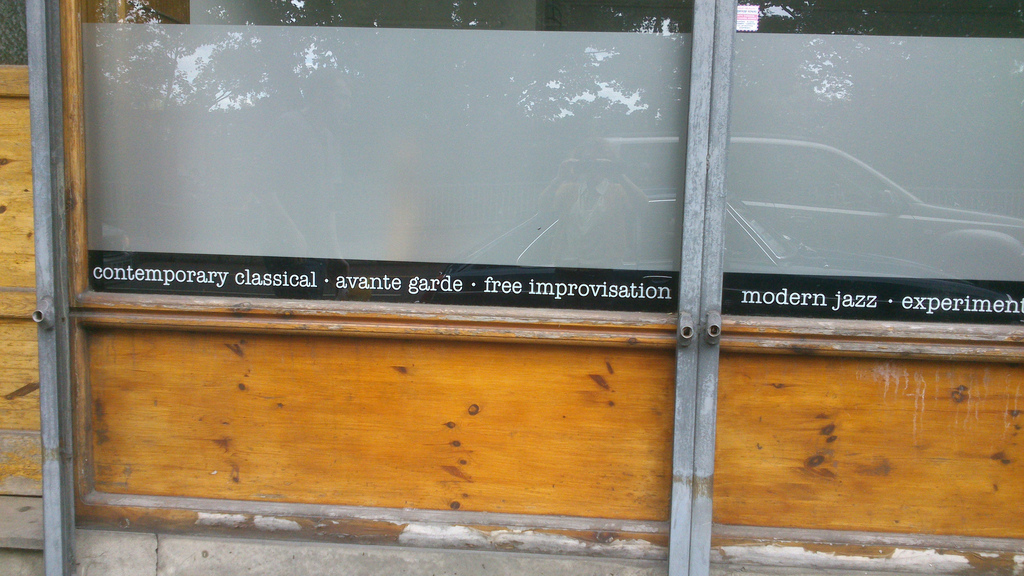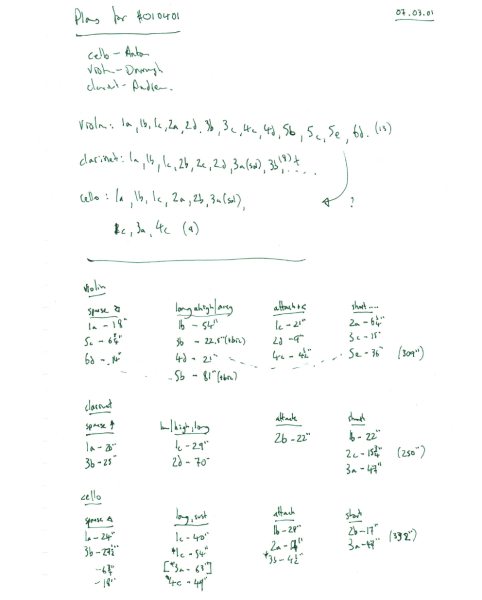#010401 was written for Andrew Sparling, Darragh Morgan and Anton Lukoszevieze for a performance organised by Tim Parkinson at Jackson’s Lane Community Theatre near Archway, just down the road from Mark Wastell’s shop Sound 323. I was commuting to London on weekends during the 2000-2001 academic year as my wife Becky was completing a postgrad in early music at the Royal College of Music. On the weekends–and sometimes weekdays–when I was in London I’d always try to visit Mark’s shop. It was the only place within easy reach for me to get CDs of improv and work closely related to it. I was really getting in to the work of players associated with the New London Silence and some of the Berlin players they worked with. Their approach sat well with me, and the associations with Wandelweiser (who I had just been introduced to by Bryn Harrison and Tim Parkinson) combined to suggest new ways to work. I was growing increasingly interested in quiet music, not as a result of its pared down constraint and preciousness but more because the kinds of fragile sounds I wanted to work with could only be produced at vey low volume. The first few versions of #[unassigned] were both very quiet and prone to sudden noisy outbursts (normally single loud gestures), and playing with sounds that were on the verge of cracking was central to my reasoning at the time.
The piece for this performance was the first sustained attempt to reuse modules from previous versions of #[unassigned]. It was scored for clarinet, violin and cello and the players had all been involved in the previous performed versions. So this brought together both the modules and the people. By this point I was beginning to assemble a larger number of modules and had to develop some way to keep track of them for the first time. There’s a page in my notebook dated 07.03.01 that begins to catalogue the possible modules to use in this version.
I seem to have made a selection from existing modules which had a numbering system (1a, 3b, 5e etc.). From memory, these were grouped by type (e.g. harmonics) so the numbers had some meaning. The lower half of the page then groups the modules by character, such as ‘sparse [harmonic]’, ‘attack’, ‘long & high/airy’. This was my method for creating correspondences between the different types of material, enabling me to group modules with ‘short’ sounds together for instance. There is still no grid however to show the time structure: the first one in my notebook was for #021101, although they certainly existed from #030501. In my PhD commentary I noted that ‘I used the same matrix approach to creating time structures that was developed for Five pieces, converting this into a linear progression of time points organised into long sections and identically proportioned subsections’. This was drawn from the kinds of proportional structures suggested by Christian Wolff in his paper ‘On form’.
#010401 was performed in the concert alongside pieces by Tim (untitled quartet) and Laurence Crane. I think it was the first full performance of Estonia which remains one of my favourite pieces by Laurence. They were joined by Annie Parker on flute. I can’t remember what else was played for the moment.


Leave a Reply